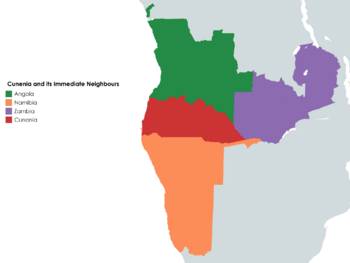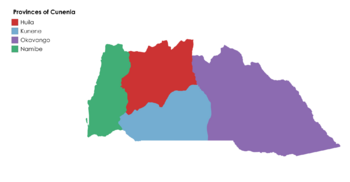Cunenia: Difference between revisions
| Line 156: | Line 156: | ||
===Agriculture=== | ===Agriculture=== | ||
[[File:Agriculture in cunenia.jpg|200px|thumb|right|Agriculture in Huila Province]] | |||
The majority of crop agriculture takes place in the higher elevations of Huila Province where rainfall is highest, and along the Kunene river where irrigation can take place. Particularly intensive growing takes place in the triangle between {{wpl|Lubango|Sá da Bandeira}}, {{wpl|Caluquembe}}, and {{wpl|Chamutete}}, and along the stretch of the Kunene river between {{wpl|Humbe}} and {{wpl|Calueque}}; these are not-coincidentally the regions with the highest proportion of Whites and Coloureds throughout the country. | |||
In the drier areas of the country, cattle herding is the most prominent form of agriculture. Cattle herding is particularly important in the eastern part of Kunene province as well as in the western and southern parts of Okavango province, although the latter is poorly controlled by the national government and contributes little to the national economy. | |||
===Transport=== | ===Transport=== | ||
Revision as of 16:27, 21 June 2019
Boer Republic of Cunenia Boererepubliek van Kunenië República Bóer da Cunenha | |
|---|---|
|
Flag | |
 Location of Cunenia between Angola, Zambia, and Namibia | |
 Provinces of Cunenia | |
| Status | Unrecognized state |
| Location | Middle Africa |
| Capital | Pereira d'Eça |
| Largest city | Sá da Bandeira |
| Official languages | Afrikaans |
| Recognised national languages | Portuguese |
| Common languages | Nyaneka, Herero, Ovambo, !Kung, Khoe, RuKwangali, and others |
| Ethnic groups | |
| Demonym(s) | Cunenian |
| Government | Parliamentary Republic |
| Pieter Strydom | |
| Hans Willem Trichardt | |
| Legislature | Volksraad |
| Independence from Angola | |
| 27 May 1874 | |
• Angolan Independence | 11 November 1975 |
| 1975 — 2002 | |
| Area | |
• Total | 422,505 km2 (163,130 sq mi) |
• Water (%) | negligible |
| Population | |
• 2014 estimate | 4,301,700 |
• Density | 10.181/km2 (26.4/sq mi) |
| Gini | 42.7 medium |
| HDI | medium |
| Currency | Pound sterling (£) (GBP) |
| Time zone | UTC+1 (WAT) |
| Driving side | right |
| Calling code | +294 |
| Internet TLD | .cnh |
Cunenia (Afrikaans: Kunenië; Portuguese: Cunenha), officially the Boer Republic of Cunenia (Afrikaans: Boererepubliek van Kunenië; Portuguese: República Bóer da Cunenha) is an unrecognised state and disputed territory in the southwestern part of the internationally recognised territory of Angola.
Cunenia has historically been a region of uncharacteristically high White European settlement, particularly by Afrikaners during the Dorsland Trek of the 1870s and by Portuguese settlers during the 1880s and 1890s. A large community of mixed-race people exists as well. Afrikaans is the sole official language of the country and the mother tongue of the majority of white and mixed-race people, but Portuguese is widely spoken across all ethnic groups and may be considered a secondary lingua franca.
Alarmed by the decolonisation of Africa and the prospect of majority rule at the hands of a vengeful native populace, the predominantly white government of the region of Cunenia declared the region's independence from Angola on the 11th of November, 1975 — the very same day of Angola's independence from Portugal. The area was the site of armed conflict as part of the Angolan Civil War which lasted from independence to 2002. Hostilities have ceased, but the government of Angola does not acknowledge or recognise the existence of the Republic of Cunenia as a political entity. The situation is considered to be a frozen conflict, as no formal peace has been reached despite the end of the armed conflict.
Cunenia is nominally a parliamentary republic, but in practice political franchise is limited to white and coloured Afrikaans-speaking citizens, and elections have been indefinitely suspended. The President, Pieter Strydom, has been in power since 1997; under his authoritarian regime, the state's various administrative and security instruments are alleged to have committed numerous human rights violations.
Etymology
The name Cunenia (as well as its Afrikaans and Portuguese forms, Kunenië and Cunenha respectively) is derived from the Cunene River which flows from north to south from the Angolan highlands through the middle of the country before turning westward, where it forms the border between Cunenia and Namibia before emptying into the Atlantic Ocean. It is one of the few perennial rivers in the region, spanning a length of 1,050 kilometres (652 mi), with a drainage basin 106,560 square kilometres (41,143 sq mi) in area. The river and its surrounding area were the primary areas of Boer settlement during the Dorsland Trek.
Cunenia is the only state to officially be known as a Boer Republic, a historical term used to refer to the former independent Afrikaner states in central and eastern South Africa and Namibia. The designation was intentionally chosen to foster a sense of Boer ethnic nationalism among the white and coloured Afrikaans-speaking communities present in the region.
History
Geography
Politics and government
Economy
Agriculture
The majority of crop agriculture takes place in the higher elevations of Huila Province where rainfall is highest, and along the Kunene river where irrigation can take place. Particularly intensive growing takes place in the triangle between Sá da Bandeira, Caluquembe, and Chamutete, and along the stretch of the Kunene river between Humbe and Calueque; these are not-coincidentally the regions with the highest proportion of Whites and Coloureds throughout the country.
In the drier areas of the country, cattle herding is the most prominent form of agriculture. Cattle herding is particularly important in the eastern part of Kunene province as well as in the western and southern parts of Okavango province, although the latter is poorly controlled by the national government and contributes little to the national economy.
Transport
Demographics
Cunenia has a population of approximately 4,301,700 inhabitants according to a 2014 estimate. 80.18% of the population consists of indigenous Black Africans, mostly of the Nyaneka-Humbe ethnic group, but with important Ovambo, Herero, Himba, Chokwe, Xindonga, and Nganguela minorities. About 3% of the population is made up of the San and Khoekhoe people. 9.2% of the population are people of mixed indigenous and European ancestry, referred to as coloureds; this includes both the Baster and Griqua communities. 7.12% of the population are White Africans of European Ancestry.
Languages
Afrikaans is the official language of Cunenia, and is the primary home language of about 90% of Whites and nearly all Coloureds in the country. A small population of Blacks, known locally as the Swartboertjies, also speak Afrikaans natively. The local variety of Afrikaans is derived from the Eastern Frontier dialect spoken by the Voortrekkers, and the local accent is quite similar to those of the Transvaal region.
Unofficially, Portuguese is widely in use, particularly as a lingua franca among unrelated indigenous tribes. The status of Portuguese as an unofficial national language is a relic of four centuries of Portuguese colonial rule in the area, ending in 1975. Portuguese is also spoken natively by many urban Blacks, and it is estimated that perhaps 47% of all Black Cunenians speak Portuguese as their primary home language, making it the most natively spoken language in the country. Several other unofficial languages carry recognised or protected status in their native ranges in more rural areas, including Herero, Ovambo, !Kung, Khoe, RuKwangali, and others. Unofficial languages may be used in certain official contexts in limited areas where it is determined that these languages are prevalent and circumstances "prevent effective communication in Afrikaans".
Religion
Cunenia is a majority Christian country. Official statistics do not exist, but it is estimated that approximately 70% of the country's population belong to the Catholic Church. The dominant White and Coloured minority however belong primarily to protestant faiths, most notably the Nederduitse Gereformeerde Kerk and the Nederduitsch Hervormde Kerk van Afrika. Only 1% to 2% of the population are Muslims, most of whom are immigrants from other African countries. Traditional indigenous religions are practiced by a very small minority, generally in peripheral rural zones.




